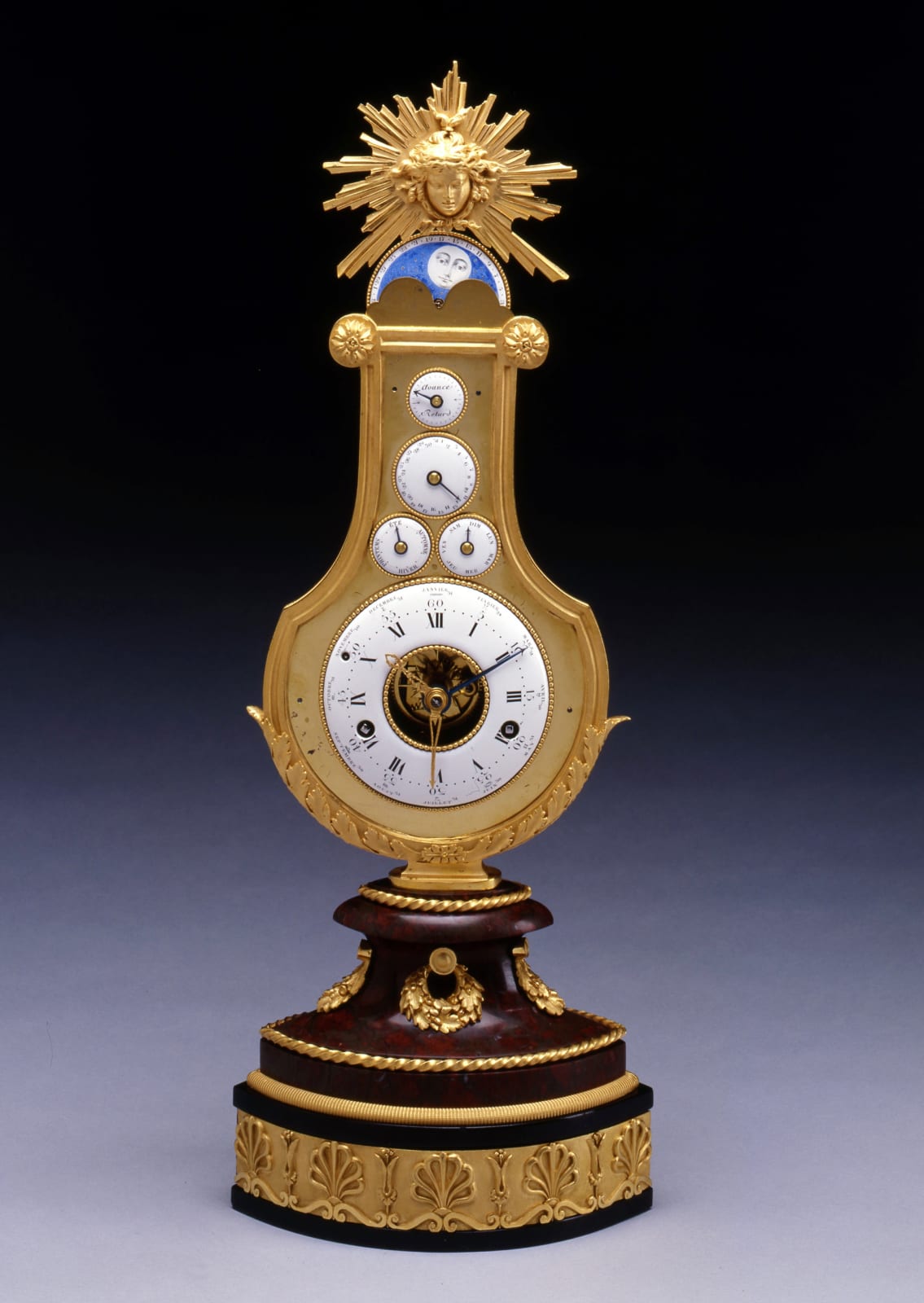Jean-Louis Bouchet (attributed to) 1737-1793
Literature
Jean-Dominique Augarde, "Les Ouvriers du Temps", 1996, p. 284, pl. 218, illustrating a comparable astronomical skeleton clock by Jean-Louis Bouchet also with cut out main dial and similarly with four subsidiary enamelled dials and painted moon phase dial.
A superb and very rare Louis XVI gilt bronze and jasper astronomical lyre clock of eight day duration attributed to Jean-Louis Bouchet and most probably retailed by Martinet à Paris, the main dial with cut out centre to reveal the skeletonised movement, with outer white enamel ring showing the names of the months and signs of the zodiac and inner Arabic and Roman numerals for the minutes and hours, with three winding squares: one at four o'clock for the going, one at eight o'clock for the striking and the third at ten o'clock for the lunar and calendar regulation, with a fine pair of pierced gilt brass hands for the hours and minutes and a blued steel pointer for the calendar indications. With four subsidiary dials above the main dial: at top for advance and retard, at centre to indicate the days of the month, to the lower left for the four seasons of the year and lower right for the days of the week, the subsidiary dials surmounted by a beautiful blue enamelled moon phase dial numbered 1-29 ½ for the lunar indications.
The twin barrelled movement for the eight day going, with silk thread suspension, verge escapement and outside count wheel for the strike, with calendar mechanism powered by the striking power. The superb case surmounted by a large gilt bronze Medusa mask within a sunburst with a pair of rosettes below and either side of the painted moon phase dial, the gilt bronze lyre-shaped body with acanthus band on an elliptical jasper pedestal with rope bands and wreaths hung from rings on a black marble base with broad anthemion band
Paris, date circa 1785
Height 64 cm, width of base 20 cm, depth of base 12 cm.
Although there are no apparent signatures on the dial or movement, the intricate complex movement compares closely with other mechanisms made by Jean-Louis Bouchet (1737-92) as well as those retailed by the mercier-horloger Martinet. Bouchet, who was received as a maître-horloger in 1762, was appointed Horloger du Roi by virtue of supplying the Garde-Meuble. He was an extremely talented maker and one of the first French makers of skeleton clocks. Bouchet supplied a number of complex pieces to Louis XV including one with astronomical indications, described as a "clock composed of different round movements in a crystal case, so that the different springs can be seen". He delivered it to King Louis XV in 1776 for Château de Bellevue, where he was placed in responsibility of maintaining all the clocks in the King's château. In 1768 he supplied miniaturized movements with astronomical indications for an ivory clock, turned by M. de Fontanieu for the King. He is also known to have made another clock with six dials and three turning circles, 1779-81.
Bouchet also created classical pieces of which four were supplied to the Garde-Meuble. He used cases by the finest makers such as Philippe Caffieri, the Osmonds, Balthazar Lieutaud, J-N. Clavelle and Jean Hauré; in addition his dial were supplied by Joseph Coteau and Edme-Portail Barbichon and his springs by Trabant. Other works by Bouchet can be admired at the Hermitage Museum, Saint Petersburg and the Archives Nationales, Paris.
The present clock is presumed to have been retailed by the Parisian mercier-horloger Hubert Martinet, since it compares closely with a multi-dialed clock surmounted by a moon phase made for the export market bearing the name Martinet London, illustrated in the Richard Redding catalogue, 1991/1992, p. 56. The mercier-horloger, who by virtue of his title only retailed clocks and thus differed from the mercier-marchand, who dealt in a variety of works of art.
